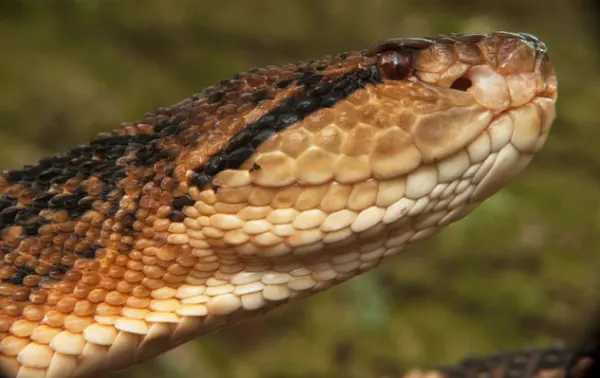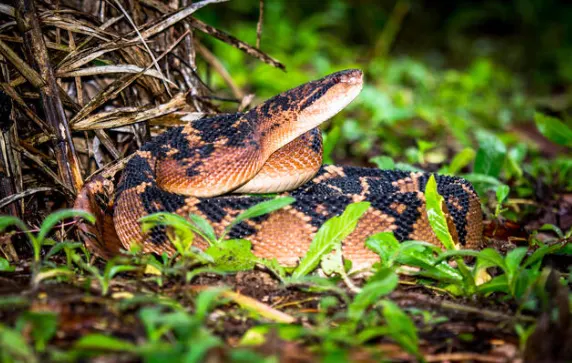The Bushmaster snake, known scientifically as Lachesis, is a fascinating yet fearsome reptile that inhabits the rainforests of Central and South America. With its formidable size, potent venom, and elusive nature, this snake has intrigued both scientists and adventurers alike. In this blog post, we will explore the characteristics, habitat, behavior, and conservation status of the Bushmaster snake, shedding light on why this species is both respected and feared in the animal kingdom.

Table of Contents
Characteristics of the Bushmaster Snake
The Bushmaster snake is the largest venomous snake in the Americas, with some individuals reaching lengths of up to 10 feet (3 meters). It is a member of the pit viper family, characterized by heat-sensing pits located between the eyes and nostrils. These pits allow the snake to detect warm-blooded prey even in complete darkness, making it an effective nocturnal hunter.
Bushmasters have a distinctive appearance with a thick, muscular body covered in keeled scales. Their coloration varies from reddish-brown to yellowish-brown, often with dark triangular patterns along the back. This coloration provides excellent camouflage in their forested habitats, allowing them to remain hidden from both predators and prey.
Habitat and Distribution
Bushmasters are found in tropical rainforests, typically in regions with high humidity and dense vegetation. They are native to Central and South America, with their range extending from Costa Rica to northern South America, including countries like Colombia, Venezuela, Ecuador, Peru, and Brazil.
These snakes prefer undisturbed areas of the forest, often near water sources such as streams or rivers. They are primarily terrestrial but are also capable climbers, sometimes found in low-hanging branches or dense undergrowth.
Behavior and Diet
Bushmasters are solitary and primarily nocturnal, spending most of the day hidden under logs, in burrows, or among thick vegetation. They are ambush predators, relying on their camouflage and patience to strike unsuspecting prey. Their diet consists mainly of small mammals such as rodents, but they may also consume birds and other reptiles.
When hunting, the Bushmaster uses its heat-sensing pits to detect the body heat of prey animals. Once a suitable target is within range, the snake strikes with incredible speed, delivering a potent dose of venom through its long, hollow fangs. The venom is hemotoxic, causing tissue damage and disrupting the blood’s ability to clot, leading to the rapid incapacitation of the prey.
Despite their fearsome reputation, Bushmasters are generally reclusive and avoid contact with humans. They are not aggressive by nature and will usually flee if given the opportunity. However, when threatened or cornered, they can deliver a dangerous bite, which can be fatal if not treated promptly.
Reproduction and Lifespan
Bushmasters have a unique reproductive strategy compared to other pit vipers. They are oviparous, meaning they lay eggs rather than giving birth to live young. The female Bushmaster will lay a clutch of 10 to 20 eggs in a secluded, warm location, often near decaying vegetation that provides additional heat for incubation. She will remain with the eggs, guarding them until they hatch, which typically occurs after about two to three months.
The hatchlings are fully independent from birth, equipped with venom and the ability to hunt. However, they are more vulnerable to predators than adults and must rely on their camouflage and stealth to survive.
In the wild, Bushmasters have a relatively long lifespan, with some individuals living up to 20 years or more. However, their populations are threatened by habitat loss, deforestation, and illegal collection for the pet trade, leading to concerns about their conservation status.
Conservation Status and Threats
The Bushmaster snake is currently listed as a species of Least Concern by the International Union for Conservation of Nature (IUCN). However, localized populations are under threat due to habitat destruction caused by deforestation, agriculture, and urbanization. In some areas, Bushmasters are also killed by humans out of fear or for their skins.
Conservation efforts are needed to protect the remaining populations of Bushmasters, particularly in regions where their habitats are rapidly disappearing. Preserving large tracts of rainforest and enforcing laws against the illegal wildlife trade are essential steps in ensuring the survival of this remarkable species.
Q&A Section
Q: Why is the Bushmaster snake considered dangerous?
A: The Bushmaster snake is considered dangerous due to its large size, potent venom, and ability to strike quickly. Its venom is hemotoxic, meaning it can cause severe tissue damage and disrupt blood clotting, leading to potentially fatal outcomes if not treated promptly.
Q: How does the Bushmaster snake detect its prey?
A: The Bushmaster snake uses heat-sensing pits located between its eyes and nostrils to detect the body heat of warm-blooded prey. This allows the snake to hunt effectively even in complete darkness.
Q: Are Bushmasters aggressive towards humans?
A: No, Bushmasters are generally not aggressive towards humans. They are reclusive and prefer to avoid contact. However, they can become defensive and deliver a dangerous bite if threatened or cornered.
Q: What is the primary diet of the Bushmaster snake?
A: The primary diet of the Bushmaster snake consists of small mammals such as rodents. They may also consume birds and other reptiles.

Q: How does the Bushmaster snake reproduce?
A: Bushmasters are oviparous, meaning they lay eggs. The female lays a clutch of 10 to 20 eggs in a warm, secluded location and guards them until they hatch. The hatchlings are independent from birth.
Q: What are the main threats to the Bushmaster snake?
A: The main threats to the Bushmaster snake include habitat loss due to deforestation, agriculture, and urbanization, as well as illegal collection for the pet trade. Conservation efforts are needed to protect their populations.
The Bushmaster snake, with its impressive size and powerful venom, is a testament to the diversity and complexity of the animal kingdom. While it is a creature to be respected and approached with caution, it also plays a vital role in its ecosystem as a predator. Through understanding and conservation, we can ensure that this remarkable species continues to thrive in the wild.
- Enchi Ball Python: A Unique and Stunning Morph of Python regius - March 27, 2025
- Emerald Tree Monitor: The Enigmatic Green Guardian of the Rainforest - March 26, 2025
- The Egyptian Cobra (Naja haje): A Fascinating Serpent - March 25, 2025
